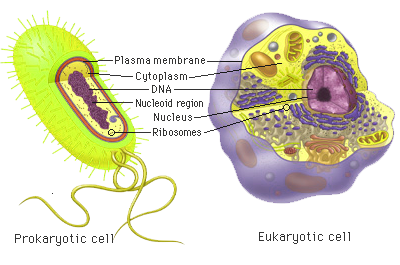Difference between eukaryotic and prokaryotic cells.
Characteristic | Prokaryote | Eukaryote |
Size of the cell | Small in size | Vary is size, generally larger than prokaryotes |
Nucleus | Nucleus with nuclear membrane is absent | A well-defined nucleus with nuclear membrane is present |
Membrane-enclosed organelles | Organelles like mitochondria and plastids, which have a membrane around them are absent | Membrane-enclosed organelles like mitochondria and plastids are present |
Cell wall | Cell wall is usually present in prokaryotes and is composed of peptidoglycan | Cell wall is usually present in plant cells and is composed of cellulose |
Genetic material | Present as nucleoid | Present inside the nucleus |


